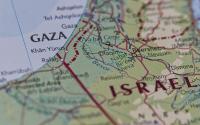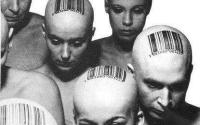"You just ask around town," says Hilda Pe-a, who monitors border crossings for the Jesuit Refugee Service. "People know who the scouts are. You just tell them what kind of child you are looking for and they can bring across whatever it is that you want."
There is a thriving trade in Haitian children in the Dominican Republic, where they are mostly used for domestic service, agricultural work or prostitution. Eight-year-old Jesus Josef was one of them. Numbed by a mixture of trauma and shyness, this small boy with huge eyes cannot recall how he left his three brothers and mother in Haiti and ended up doing domestic work for a Dominican family in Barahona, 120 miles from the capital, Santo Domingo.
Torture
Jesus sits quietly as Father Pedro Ruquoy, who runs a refuge near Barahona, tells how he escaped from the family and ran away to a local hospice. When he arrived his neck was twisted from carrying heavy loads on his shoulder and the marks on his slender torso suggested ill-treatment. The Dominican family found out where he was and came to the hospice demanding either his return or 10,000 pesos for the loss. "They used him as a slave," says Mr Ruquoy. "And they tortured him."
Nobody knows quite how many Haitian children like Jesus there are in the Dominican Republic. A Unicef report in 2002 put the figure at around 2,500, although some NGOs think it might be twice that. Most boys under the age of 12 end up begging or shoe shining and giving their proceeds to gang leaders; most girls of that age are used as domestic servants. Older boys are taken to work in construction or agriculture; teenage girls often end up in prostitution.
Tensions have long existed between the two countries that share the island of Hispaniola. In May, and then again last month, the Dominican Republic summarily deported thousands of Haitians, many of whom had the right to stay. A former Haitian consul to the republic, Edwin Paraison, says the situation had not been this bad since the former Dominican military leader Rafael Trujillo massacred 20,000 Haitian sugar cane workers in 1937. "This is the first time regular people are trying to run Haitians out of the country," he says. "There is an organised campaign to reject Haitian presence."
But even as Haitians are reviled, they are also needed for their cheap labour. The manner in which the children arrive varies. Some are kidnapped but most often their parents not only know, but actually pay "busones" or scouts to ensure their safe passage in the hope that they will have a better life.
"Half of all Haitians struggle to eat even once a day," says Helen Spraos, Christian Aid's Haiti representative. "It doesn't take much to push people over the brink. If the rains fail or someone falls ill, they have to sell what little they have - perhaps a pig or a goat - to buy medicines. Eventually they have to sell their land. Once they reach rock bottom, the one way they can provide for their children is by sending them to live in the cities or in the Dominican Republic. There at least they may be fed and have some prospects for making a living."
Border
Such stories are familiar in the narrow alleyways in the barrios of Christo Rey, an area of Santo Domingo. Nine-year-old Louseny's mother died when she was a baby and she was raised by her grandmother in central Haiti. Last month, her grandmother paid her "aunt" to bring her over the border and leave her with people Louseny did not know. Louseny says she misses her home.
Florencia Talon, who looks after 10-year-old Violetta after her mother left her, says people have approached her in the street to ask her to take in children. "In most cases the Haitian family is told that the child will go to someone who will help raise the child," says Father Jose Nu-ez, the director of the Jesuit Refugee Service in Santo Domingo. "They are told they will get an education and have a better chance. But this actually happens very, very rarely. In most cases they are verbally or physically abused and mistreated."
Getting them over the border is the easy part. According to Unicef, about a third of trafficked children come through the mountains; the rest go through official border checkpoints. On market day in Dajabón, the only papers you need to get across the bridge that links the two countries are peso notes to bribe the border guards. Those who are turned back simply wade across the Massacre river.
"The scouts are paid around 600 pesos, half of which goes to the scout and half of which is paid to the immigration authorities as a bribe," says Angelica Lopez, the Jesuit Refugee Service director in Dajabón. "The Dominican state and the military are completely complicit in the trafficking." Once across, the child will be passed through series of more informal networks until they are placed with a family, gang or into work.
There is a law against trafficking in the Dominican Republic, but it is rarely enforced and the authorities remain in denial. "There is no trafficking," says Juan Casilla, the state prosecutor for Dajabón. "I have never had one case of trafficking lodged with my office."
Mr Ruquoy says the sugar companies are also complicit, paying Haitian traffickers 2,000 Haitian gourdes (£26.44) for each worker.
Over at the sugar fields near Barahona, the smell of burning cane stems and the sound of slashing machetes suggest a scene from another century. Hundreds of men, their ragged clothes held together by sweat and grime, hack away beneath a high sun and above the smouldering stems, which are easier to cut when burned. From 6am until 6pm they are there, swinging, yanking, slicing and burning for about £1 a day. Ask any of them and they will tell you they are 18. Look and you will see that about one in eight could not possibly be older than 16.
Cheated
Jesus Nord, 15, used to be one of them. Two years ago he paid a Haitian scout 50 gourdes to smuggle him over the border and then went to work in the fields for a year. After being cheated of his earnings and physically abused, he left. "I was never there when they weighed the sugar so they would give me less then they owed," he says. "They also used to beat me to make me work faster."
The Barahona refinery, the Consorcio Azucarero Central, is part of a consortium, whose main shareholder in Guatemala could not be reached for comment.
The trafficking of Haitian children represents the bottom rung of a migratory ladder through the Americas that sees Dominicans striving to get to Puerto Rico, and Puerto Ricans moving to the US. "The market for cheap labour keeps people moving," says Mr Nu-ez. "Since so many other countries have closed their doors to Haitians the only chance they have is to go to the country that is slightly less poor than Haiti and the easiest to get to. The economy could not function without them. But it takes a terrible toll on the individuals."
Haiti
Population 8.1m (July 2005)
Infant mortality rate: 73.45 deaths for every 1,000 live births
Life expectancy: 52.92 years
Politics Interim president, Boniface Alexandre, sworn in after former leader Jean-Bertrand Aristide went into exile in February 2004
GDP: $12bn (2004)
Real growth rate: -3.5% (2004)
Labour force Agriculture 66%, industry 9%, services 25%
Unemployment: widespread; more than two-thirds of the labour force do not have formal jobs (2002).
Dominican Republic
Population 8.9m (July 2005)
Infant mortality rate: 32.38 deaths for every 1,000 live births
Life expectancy at birth: 67.26 years
Politics Leonel Fernandez began his second non-consecutive term as president in August 2004, after winning elections in May for the Dominican Liberation party
GDP: $55bn (2004)
Real growth rate: 1.7% (2004)
Labour Force Agriculture 17%, industry 24.3%, services and government 58.7% (1998)
Unemployment rate: 17% (2004).
Video22.09.05: Gary Younge reports from the Dominican Republic (QuickTime)22.09.05: Gary Younge reports from the Dominican Republic (Windows Media Player)LinkFind out what Christian Aid is doing to counter the trafficking of children from Haiti into Dominican RepublicNews guide20.12.2001: Media in the Dominican Republic






